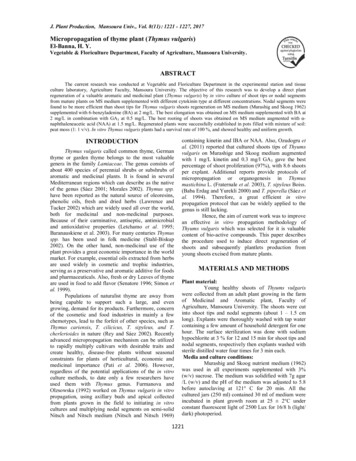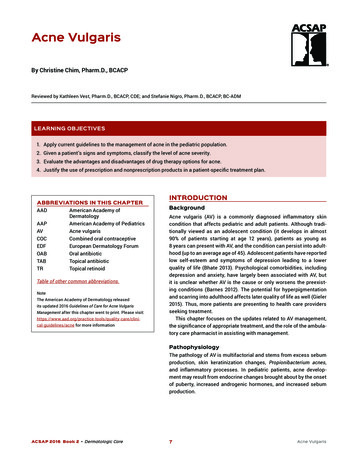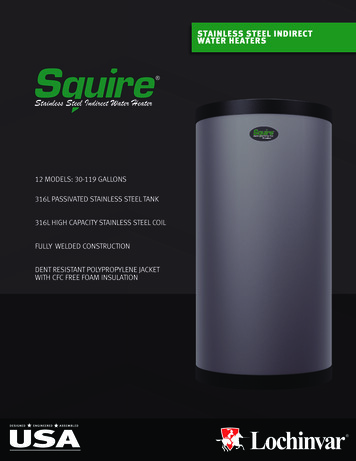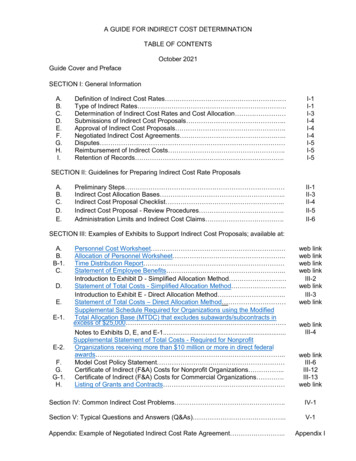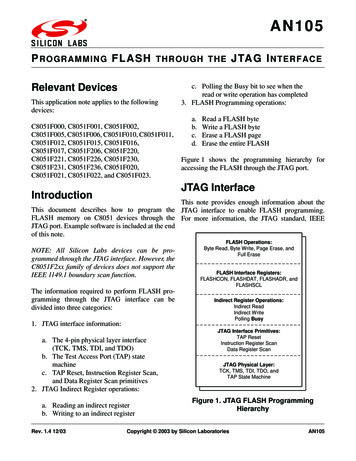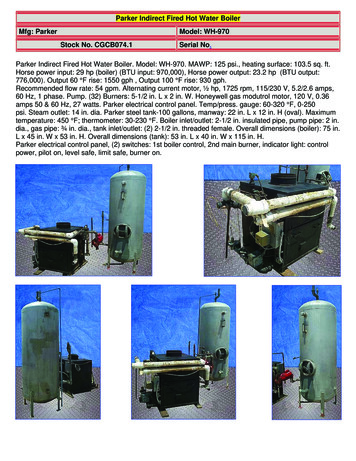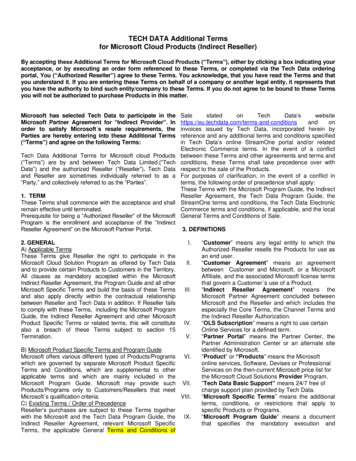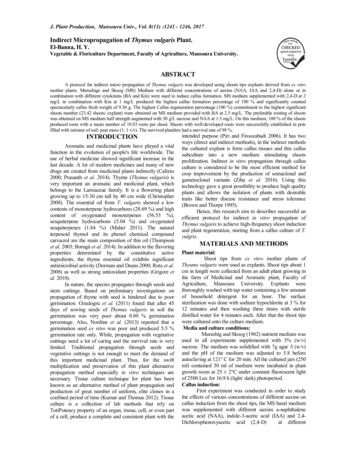
Transcription
J. Plant Production, Mansoura Univ., Vol. 8(11) :1241 - 1246, 2017Indirect Micropropagation of Thymus vulgaris Plant.El-Banna, H. Y.Vegetable & Floriculture Department, Faculty of Agriculture, Mansoura University.ABSTRACTA protocol for indirect micro propagation of Thymus vulgaris was developed using shoots tips explants derived from ex vitromother plants. Murashige and Skoog (MS) Medium with different concentrations of auxins (NAA, IAA and 2,4-D) alone or incombination with different cytokinins (BA and Kin) were used to induce callus formation. MS medium supplemented with 2,4-D at 2mg/L in combination with Kin at 1 mg/L produced the highest callus formation percentage of 100 % and significantly countedspectacularly callus fresh weight of 9.56 g. The highest Callus regeneration percentage (100 %) commitment to the highest significantshoots number (23.42 shoots/ explant) were obtained on MS medium provided with BA at 2.5 mg/L. The preferable rooting of shootswas obtained on MS medium half strength augmented with 30 g/L sucrose and NAA at 1.5 mg/L. On this medium, 100 % of the shootsproduced roots with a mean number of 19.83 roots per shoot. Shoots with well-developed roots were successfully established in potsfilled with mixture of soil: peat moss (1: 1 v/v). The survived plantlets had a survival rate of 98 %.INTRODUCTIONAromatic and medicinal plants have played a vitalfunction in the evolution of people's life worldwide. Theuse of herbal medicine showed significant increase in thelast decade. A lot of modern medicines and many of newdrugs are created from medicinal plants indirectly (Calixto2000; Prasanth et al. 2014). Thyme (Thymus vulgaris) isvery important an aromatic and medicinal plant, whichbelongs to the Lamiaceae family. It is a flowering plantgrowing up to 15-30 cm tall by 40 cm wide (Christopher2008). The essential oil from T. vulgaris showed a lowcontents of monoterpene hydrocarbons (28.69 %) and highcontent of oxygenated monoterpenes (56.53 %),sesquiterpene hydrocarbons (5.04 %) and oxygenatedsesquiterpenes (1.84 %) (Maher 2011). The naturalterpenoid thymol and its phenol chemical compoundcarvacrol are the main composition of this oil (Thompsonet al. 2003; Borugă et al. 2014). In addition to the flavoringproperties determined by the constitutive activeingredients, the thyme essential oil exhibits significantantimicrobial activity (Dorman and Deans 2000; Rota et al.2008) as well as strong antioxidant properties (Grigore etal. 2010).In nature, the species propagates through seeds andstem cuttings. Based on preliminary investigations onpropagation of thyme with seed is hindered due to poorgermination. Ozudogru et al. (2011) found that after 45days of sowing seeds of Thymus vulgaris in soil thegermination was very poor about 0.80 % germinationpercentage. Also, Nordine et al. (2013) reported that agermination seed ex vitro was poor and produced 5.5 %germination rate only. While, propagation with vegetativecuttings need a lot of caring and the survival rate is verylimited. Traditional propagation through seeds andvegetative cuttings is not enough to meet the demand ofthis important medicinal plant. Thus, for the swiftmultiplication and preservation of this plant alternativepropagation method especially in vitro techniques arenecessary. Tissue culture technique for plant has beenknown as an alternative method of plant propagation andproduction of great number of uniform, elite clones in aconfined period of time (Kumar and Thomas 2012). Tissueculture is a collection of lab methods that rely onTotiPotency property of an organ, tissue, cell, or even partof a cell, produce a complete and consistent plant with theintended purpose (Piri and Firoozabadi 2006). It has twoways (direct and indirect methods), in the indirect methodsthe cultured explant is form callus tissues and this callussubculture into a new medium stimulating shootsproliferation. Indirect in vitro propagation through callusculture is considered to be the most efficient method forcrop improvement by the production of somaclonal andgametoclonal variants (Ziba et al. 2016). Using thistechnology gave a great possibility to produce high qualityplants and allows the isolation of plants with desirabletraits like better disease resistance and stress tolerance(Brown and Thorpe 1995).Hence, this research aim to describes successful anefficient protocol for indirect in vitro propagation ofThymus vulgaris to achieve high-frequency shoot inductionand plant regeneration, starting from a callus culture of T.vulgris.MATERIALS AND METHODSPlant material:Shoot tips from ex vitro mother plants ofThyums vulgaris were used as explants. Shoot tips about 1cm in length were collected from an adult plant growing inthe farm of Medicinal and Aromatic plant, Faculty ofAgriculture, Mansoura University. Explants werethoroughly washed with tap water containing a few amountof household detergent for an hour. The surfacesterilization was done with sodium hypochlorite at 3 % for12 minutes and then washing three times with steriledistilled water for 4 minutes each. After that the shoot tipswere cultured onto the culture medium.Media and culture conditions:Murashig and Skoog (1962) nutrient medium wasused in all experiments supplemented with 3% (w/v)sucrose. The medium was solidified with 7g agar /l (w/v)and the pH of the medium was adjusted to 5.8 beforeautoclaving at 121 C for 20 min. All the cultured jars (250ml) contained 30 ml of medium were incubated in plantgrowth room at 25 2 C under constant fluorescent lightof 2500 Lux for 16/8 h (light/ dark) photoperiod.Callus induction:First experiment was conducted in order to studythe effects of various concentrations of different auxins oncallus induction from the shoot tips, the MS basal mediumwas supplemented with different auxins a-naphthaleneacetic acid (NAA), indole-3-acetic acid (IAA) and 2,4Dichlorophenoxyacetic acid (2,4-D)at different
El-Banna, H. Y.replicates included 12 jars for each treatment. The in vitroplantlets were bring out from the gars, rinsed under tapwater to clean all traces of media and then single plantletswere cultured onto pots filled with soil: peat moss (1: 1v/v).Statistical analysis:Data of all experiment was subjected to analysis ofvariance (ANOVA) by the general linear models (GLMs)procedure using (SAS) Statistical Analysis System (2000).Mean comparisons were performed using the leastsignificant difference (LSD) method according to (Gomezand Gomez, 1984). A significance level of 5 % was usedfor all statistical analyses.concentrations of 0.0, 0.5, 1, 1.5, 2 and 3 mg/L. A factorialexperiment in a randomized complete block design wasused with 4 replicates included 12 jars for each treatment.After 30 day of culture, data were recorded.Second experiment was carried out in order to studythe effect of combination between auxin and cytokinin oncallus induction. The best single auxin results obtainedfrom the first experiment (2,4-D at 2 mg/L and NAA at 1.5mg/L) were further combined with three cytokinins; 6benzyladenine (BA), kinetin (Kin) and thidiazuron (TDZ)at a concentration of 1 mg/L. A completely randomizeddesign was used with 4 replicates included 12 jars for eachtreatment. After 30 day of culture, data were recorded.Callus regeneration:For plant regeneration, organogenic, friable callusderived from MS medium supplemented with 2,4-D at 2mg/L in combination with Kin at 1 mg/L (the best result inthe second experiment) were cut into piece of 1 1 cm2and inoculated on MS medium supplemented with twotypes of cytokinins (BAP and Kin) each alone at differentconcentrations of (1.0, 1.5, 2.0, 2.5 and 3.0 mg/L).Observations on the percentage of callus forming shoots,shoots number, shoot length and leaves number perresponding cultures were recorded. After 4 weeks ofculture, data were recorded. A completely randomizeddesign was used with 4 replicates included 12 jars for eachtreatment.Induction of rooting and acclimatization:For root induction, the effect of MS basal mediumstrength (3/4 or 1/2 strength), two carbon source (sucroseor glucose) at different concentrations (20, 30 and 40 g/L)was studied. NAA was added to the media at concentrationof 1.5 mg/L (the best concentration obtained for rooting indifferent researches). A factorial experiment in arandomized complete block design was used with 4RESULTS AND DISCUSSIONI- Callus induction stage:1- Effect of auxin type, auxin concentration and theirinteractions on callus formation of Thymusvulgaris shoot tips.This experiment was conducted to test the effect ofdifferent auxins (NAA, IAA and 2,4-D) at variousconcentrations 0.0, 0.5, 1.0, 1.5, 2.0 and 3.0 mg/L as wellas their interactions on callus formation percentage, callusweight. The results were recorded after 4 weeks of cultureon MS medium and are shown in Table (1).Effect of auxin type (A) on callus formation:Concerning the effect of auxin type on callusformation percentage and callus weight, data in Table (1)showed that significant differences were noticed among thedifferent used auxins, since medium supplemented with2,4-D recorded the highest significant callus formationpercentage (58.3 %) followed with media supplementedwith NAA (48.5 %).Table 1. Effect of auxin type, auxin concentration and their interactions on callus formation of Thymus vulgaris.Callus induction(%)ParametersAuxin .041.7Callus freshweight (g)Mean of (B)LSD at 5%Mean of (B)LSD at 5%Auxin concentrations(mg/L) (B)1.01.5Mean of 6.783.375.058.352.858.3B 10.563.9A 7.461.1A B .903.70A 0.134.50B 0.195.20It was clear from the same table that adding 2,4-Don the nutrient medium significantly produced the heaviestcallus fresh weight of 4.7 g, when compared with addingNAA or IAA, since it was 4.5 and 1.3 g, respectively asshown in Fig. 1.4.70A B 0.33Effect of auxin concentration (B) on callus formation:Regarding the effect of auxin concentration oncallus formation percentage as shown in Table (1), theobtained results showed a positive relationship betweenauxin concentrations and callus formation percentage, it1242
J. Plant Production, Mansoura Univ., Vol. 8(11), November, 2017was noticed that every increase in auxin concentrationsfrom 0.5 mg/L up to 2.0 mg/L gradually increased callusformation percentage. The highest recorded percentage(63.9 %) was obtained with auxin at 2.0 mg/L andincreasing auxin concentration to 3 mg/L reduced callusformation percentage to 61.1 %. In contrast, the controlmedium (free auxin medium) failed to perform callus. Theresults of Mahmoud et al. (2011) on lavender plant confirmour results. From a long time it was confirmed that theaction of auxins was in relationship with the concentrationapplied.Concerning the effect of auxin concentration oncallus fresh weight, the highest significant value of callusfresh weight (5.2 g) was obtained when MS medium wassupplemented with auxin at 2.0 mg/L.Effect of the interaction between auxin type and auxinconcentration (A B) on callus formation:Data presented in the same table revealed thatadding 2,4-D on the nutrient media at the highestconcentrations of 2 mg/L recorded the highest callusformation value of 83.3%. In contrast, the control medium(free auxin medium) did not record any callus formation.Concerning the effect of the interaction betweenauxin type and auxin concentrations on callus fresh weight,data in Table (1) cleared that using medium supplementedwith 2,4-D at 2 mg/L or NAA at 1.5 mg/L significantlyrecorded the heaviest callus fresh weight of 6.80 and 6.69g, respectively. On the other hand, using IAA on mediumat all different concentrations significantly recorded thelowest callus fresh weight.Generally for callus induction, the presence of astrong auxin like 2,4-D or NAA is necessary. Simon andPetrasek (2011) referred that to the important roles of bothauxin in cell enlargement, stimulating cell division andelongation by increasing the plasticity of the cell wall.When extensibility of the wall is increased, the wallpressure around the cell decreases and the turgor pressurecaused by osmotic forces in the vacuolar sap causes waterto enter the cell, resulting in cell enlargement. Also,Gautheret (1955) reported that for the culture of a numberof callus tissues, auxin is the essential supplement which isneeded to be added to the basal medium for supplyinginorganic ions and sugars. In the present investigationincorporation of 2,4-D was found to have beneficial effecton callus formation and this was also reported in othermedicinal plants such as Ocimum sanctum (Lim et al.2009) and Achyranthes aspera (Sen et al. 2014).2- Effect of the interaction between auxin type andcytokinin type on callus formation of Thymusvulgaris shoots tips.The goal of this phase of the experiment was tostudy the effect of various auxins (NAA at 1.5 mg/L and2,4-D at 2 mg/L) and various cytokinins (BA, Kin andTDZ at 1 mg/L) in combinations. Data in Table (2)showed that culturing the shoot tip on MS mediumsupplemented with NAA in combination with Kinrecorded the lowest callus formation value of 75 %, whencompared with all of the other cases. On the other hand,culturing shoots tips on media supplemented with 2,4-D incombination with BA or Kin produced the highest callusformation percentage of 100 %.It could be noticed that, the callus fresh weightwas affected by the combination between auxin type andcytokinin type. In this concern, 2,4-D at 2 mg/L incombination with Kin at 1 mg/L significantly countedspectacularly callus fresh weight of 9.56 g when comparedwith all of the other treatments (Table 2 and Fig. 2A). Thenext positive effect in that respect was 8.46 g, when using2,4-D at 2mg/L in combination with BA at 1 mg/L.Table 2.Effect of the interaction between auxin type and cytokinin type on callus formation of Thymus vulgaris.Treatments2,4-Dat 2mg/LNAAat 1.5mg/LAuxin typeL.S.D. at 0.05Cytokinin type at1 mg/ LBAKinTDZBAKinTDZCallus induction(%)Callus fresh weight(g)Callus ts Number3.381.620.752.251.500.000.85Figure 1. A) Callus formation of Thymus vulgaris. obtained by culturing shoot tip on MS medium supplementedwith 2 mg/L of 2,4-D. B) Callus formation, obtained by culturing shoot tip on MS medium supplementedwith 1.5 mg/L of NAA.1243
El-Banna, H. Y.ABFigure 2. A) Callus formation of Thymus vulgaris. obtained by culturing shoot tip on MS medium supplemented with 2 mg/L of2,4-D in combination with Kin. B) Callus formation, obtained by culturing shoot tip on MS mediumsupplemented with 1.5 mg/L of NAA in combination with BA.In addition, it was a matter of importance to note apercentage of callus regeneration commitment with apositive relationship of shoots number. As, the highestcallus regeneration percentage of 58.3 % and the highestsignificant shoots number of 3.38 shoot obtained when MSmedium supplemented with NAA and BA at 1.5 and 1mg/L, respectively as shown in Fig. 2B. While, it wascleared that no callus regeneration on MS mediumsupplemented with 2,4-D and TDZ.Results obtained cleary indicated that callusformation was affected by the combination between auxinand cytokinin type. A ratio of auxins and cytokinins greaterthan one in the nutrient medium was effective for theinduction of callus in different plants (Nikam and Savant2009). In this study, 2, 4-D in combination with differentcytokinins was found to be essential for callus induction.Our studies are in line with (Sen et al. 2014) onAchyranthes aspera (Akram et al. 2010) on Thymusvulgaris whom reported that that the maximum frequencyof callus induction was obtained on MS mediumcontaining 1:0.5 ratio of 2, 4 D:Kin (mg/L). The efficiencyof 2,4-D in combination with cytokinins in induction ofcallus might due to their function in mitosis and DNAsynthesis (Skoog and Miller 1957).II- Callus regeneration stage:1- Effect of cytokinin type at different concentrationson callus regeneration of Thymus vulgaris.The callus formed from the previous experimentwas cultured on MS medium supplemented with variousconcentrations (1.0, 1.5, 2.0, 2.5 and 3.0 mg/L) of BA orKin for shoot regeneration (Table 3). The callus increasedin bulk and after 4 weeks of culture on regenerationmedium numerous shoots were appeared on the surface ofthe callus. Among the two cytokinins used, BA at differentconcentrations was comparatively superior in terms ofCallus regeneration percentage and shoots number. Thehighest Callus regeneration percentage (100 %)commitment to the highest significant shoots number(23.42 shoots/ explant) were obtained on MS mediumprovided with BA at 2.5 mg/L (Fig. 3A). Also, MSmedium supplemented with Kin at 3 mg/L gave 100 %Callus regeneration but with less shoots number (18.75shoots/ explant).As for shoot length and leaves number per shoot,data in Table (3) showed that for both cytokinin type (BAand Kin) there was a positive relationship betweenincrements in concentrations and both characters. But, thehighest significant shoot length (3.82 cm) and leavesnumber per shoot (9.25 leaves/ shoot) were recorded withcallus cultured on MS media supplemented with Kin at 3mg/L (Fig. 3B).Results are in agreement with data by Ziba et al.(2016) on Thymus persicus who reported that using BA orKin in regeneration medium gave the same callusregeneration percentage but BA was more effective thanKin in inducing shoots number while Kin was moreeffective in shoot length. BA is a strong cytokinin and is1244
J. Plant Production, Mansoura Univ., Vol. 8(11), November, 2017routinely used either alone or in combination with lowamount of auxin for shoot induction from callus (Irvani etal. 2010). According to Sharma and Wakhlu (2003), thesuperior role of BA over other cytokinins may be due tothe capability of plant cells and tissues to metabolizenatural plant growth regulators more easily than synthetichormones.per shoot (12.41 and 19.83 roots, respectively) with asignificant differences between the two treatments. Also,the most efficient treatment in enhancing rooting with thehighest roots number gave suitable root length (8.42 cm)(Fig. 4A). Generally increasing sugar concentrations from20 g/L up to 40 g/L significantly in all treatments increasedroot length and the highest length of root 10.71 cm wasTable 3. Effect of cytokinin type at different concenterationsachieved with MS medium half strength furthered withglucose at 40 g/L (Fig. 4B). On the other hand, the loweston callus regeneration of Thymus vulgaris.treatment for rooting percentage (66.7 %) and rootsTreatmentsCallusShoots Shoot Leavesnumber per shoot (5 roots) was ¾ strength MS mediumcytokini regeneratNumber/ Length Number/cytokinsupplemented with glucose sugar at 40 g/L. While, theionn conc.explant(cm)shootin typeshortest root length was obtained with ¾ strength MS(%)mg/Lmedium supplemented with sucrose sugar at 20 g/ L.1.066.79.252.247.22The root initiation and growth were high energy1.583.314.212.547.43requiring processes that could only occur at the expense of2.010019.162.727.94BAavailable metabolic substrates, which were mainly2.510023.422.918.13carbohydrates (Thorpe 1982). In this study, rooting of3.091.713.833.208.42thyme shoots was affected by the carbon source. In1.041.77.372.667.56general, sucrose induced the highest frequency of roots1.550.09.3752.827.81number per shoot. This is might be due to that sucrose is anKin2.075.012.543.138.26important source of carbohydrate in the culture medium as2.583.315.123.288.60well as acting as an osmoticum (Hartmann et al. 1997).3.010018.753.829.25Also, the effect of sugar concentration on root length mightL.S.D. at 0.0520.140.620.090.10be due to carbohydrate osmotic contribution, since itInduction of rooting and acclimatization:controls morphogenesis by acting as energy source and1- Effect of media strength, sugar type at different also by altering the osmotic potential of the cultureconcentrations on rooting behavior of Thymus medium, which alters such cell wall properties asvulgaris shoots.extension, hardening, and composition, followed byThis experiment was conducted to test the effect of subsequent modification in morphogenesis (Pritchard et al.MS media strength, suger type and sugar concentration on 1991). These results were in agreement with the findings ofrooting parameters of Thymus vulgaris shoots, i.e., rooting Mahmoud et al. (2011) who reported the preferable rootingpercentage, roots number per shoot and root length. The of Lavandula angustifolia shoots were gained on MSresults were recorded four weeks after culture and were medium half strength augmented with 30 % sucrose andpresented in Table (4).NAA.Data in Table (4) clearly showed that culturing theFor the further establishment, in vitro grown wellshoots on half strength MS medium supplemented with 20 rooted plantlets were washed with tap water to removeor 30 g/L sucrose achieved the highest rooting percentage agar traces and transferred to pots filled with the mixture ofof 100 % for each, when compared with all of the other soil and peat moss (1:1 by volume) for hardening. Thetreatments. Also, it was a matter of importance to observe survival rate of 98 % was achieved after 4 weeks (Fig. 4C).that the previous treatments gave the highest roots numberTable 4.Effect of media strength, sugar type at differentshoots.Rooting (%)MediaSugar typestrength203040sucrose91.791.783.33/4 strengthglucose75.083.366.7sucrose10010091.71/2 strengthglucose83.391.766.7LSD at 5 %20.8REFRENCESconcentrations on rooting behavior of Thymus vulgarisRoots number/ shootSugar conc. 88.169.165.660.54Root length 10.719.289.89Brown, D. C. W. and T. A. Thorpe (1995). Cropimprovement through tissue culture. World Journalof Microbial & Biotechnology, 11: 409-415.Calixto, J. B. (2000). Efficacy, safety, quality control,marketing and regulatory guidelines for herbalmedicines (phytotherapeutic agents). Braz. J. Med.Biol. Res. 33: 179-189.Christopher, B. (2008). RHS A-Z encyclopedia of gardenplants. Dorling Kindersley, United Kingdom.Akram, Z., F. Rezanejad and A. Safarnejad (2010). In vitroselection for NaCl tolerance in Thymus vulgaris L.Journal of Cell and Molecular Research,2(2): 86-92.Borugă, O., C. Jianu, C. Mişcă, I. Goleţ, A. T. Gruia andF.G. Horhat (2014). Thymus vulgaris essential oil:chemical composition and antimicrobial activity.Journal of Medicine and Life, Volume 7, SpecialIssue 3: 56-60.1245
El-Banna, H. Y.Dorman, H. J. D. and S. G. Deans (2000). Antimicrobialagents from plants: antibacterial activity of plantvolatile oils. Journal of Applied Microbiology,88(2): 308-316.Gautheret, R. J. (1955). The nutrition of plant tissueculture. Ann Rev Plant Physiol, 6: 433.Grigore, A., I. Paraschiv, S. Colceru-Mihul, C. Bubueanu,E. Draghici and M. Ichim (2010). Chemicalcomposition and antioxidant activity of Thymusvulgaris L. volatile oil obtained by two differentmethods. Romanian Biotechnological Letters,15(4): 5436-5443.Hartmann, H. D., D. E. Kester, F. T. Davies and R. L.Geneve (1997). Plant propagation: Principles andPractices, 6th ed. Prentice-Hall International (UK)Limited, London.Irvani, N., M. Solouki, M. Omidi, A.R. Zare and S.Shahnazi (2010). Callus induction and plantregeneration in Dorem ammoniacum D., anendangered medicinal plant. Plant Cell TissueOrgan Cult, 100: 293–299.Kasem, M. M. E. (2011). Biotechnological studies onlavender plant. Ph. D. Thesis, Faculty ofAgriculture, Mansoura University.Kumar, G. K. and T. D. Thomas (2012). High frequencysomatic embryogenesis and synthetic seedproduction in Clitoria ternatea Linn. Plant CellTissue Organ Cult, 110:141–151.Lim, Z. X., A. P. K. Ling and S. Hussein (2009). Callusinduction of Ocimum sanctum and estimation of it'stotal flavonoids content. Asian Journal ofAgricultural Sciences, 1: 55-61.Maher, A. A., A. Maqtari, S. M. Alghalibi and E. H.Alhamzy (2011). Chemical composition andantimicrobial activity of essential oil of Thymusvulgaris from Yemen. Turk J Biochem, 36:342-349.Murashige, T. and F. Skoog (1962). A revised medium forrapid growth and bioassays with tobacco tissuecultures. Physiol. Plant, 15: 473-475.Nikam, T. D. and R. S. Savant (2009). Multiple shootregeneration and alkaloid cerpegin accumulation incallus culture of Ceropegia juncea Roxb. Physiol.Mol. Biol. Plants, 15(1): 71-77.Nordine, A.; C. R. Tlemcani and A. EL Meskaoui (2013).Micropropagation of Thymus satureioides Coss. anendangered medicinal plant of Morocco. Journal ofAgricultural Technology, 9(2): 487-501.Ozudogru, E.A.; E. Kaya; E. Kirdok and S. Issever- Ozturk(2011). In vitro propagation from young and matureexplants of thyme (Thymus vulgaris and T.longicaulis) resulting in genetically stable shoots. InVitro Cellular and Developmental Biology – Plant.47(2):309–320.Piri, K. and F. N. Firoozabadi (2006). Plants tissue cultureguide. Bu-Ali Sina University Press, Hamedan,Iran, p. 214.Prasanth, R. V., R. V. Kandisa, P. V. Varsha and S.Satyam (2014). Review on Thymus vulgaristraditional uses and pharmacological properties.Medicinal and Aromatic Plants, 3:3.Pritchard, J., R. G. Wyn-Jones and A. D. Tomos (1991).Turgor, growth and rheological gradients in wheatroots following osmotic stress.Journal ofExperimental Botany, 42: 1043–1049.Rota, M. C., A. Herrera, R. M. Martínez, J. A. Sotomayorand M. J. Jordán (2008). Antimicrobial activity andchemical composition of Thymus vulgaris, Thymuszygis and Thymus hyemalis essential oils. FoodControl, 19(7): 681-687.Sen, M. K., S. Nasrin, S. Rahman and A. H. M. Jamal(2014). In vitro callus induction and plantletregeneration of Achyranthes aspera L., a high valuemedicinal plant. Asian Pac J Trop Biomed, 4(1):40-46.Sharma, R. K. and A. K. Wakhlu (2003). Regeneration ofHeracleum candicans wall plants from calluscultures through organogenesis. Plant BiochemBiotechnol, 12:71–72.Simon, S. and P. Petrasek (2011). "Why plants need morethan one type of auxin". Plant Science. 180 (3):454-460.Skoog, F. and C. O. Miller (1957). Chemical regulation ofgrowth and organ formation in plant tissues culturedin vitro. Symp Soc Exp Biol, 11: 118-130.Thompson, J. D., J. C. Chalchat, A. Michet, Y. B. Linhartand B. Ehlers (2003). Qualitative and quantitativevariation in monoterpene co-occurrence andcomposition in the essential oil of Thymus vulgarischemotypes. Journal of Chemical Ecology, 29(4):859-880.Thorpe, T. (1982). Carbohydrate utilization andmetabolism. In: Bonga, J.M., Durzan, D.J. (Eds.),Tissue Culture in Forestry. Martinus NijhoffPublishers, London: 325-368.Ziba, B., M. H. Mirjalili and A. Sonboli (2016). In vitrocallus induction and micropropagation of Thymuspersicus (Lamiaceae), an endangered medicinalplant. Crop Breeding and Applied Biotechnology16: 48-54.(Thymus vulgaris) االكثار الدقيق الغيرالمباشر لنبات الزعتر ھبة يوسف البنا جامعة المنصورة - كلية الزراعة - قسم الخضر و الزينة استخدمت بيئة . اجري ھذا البحث بھدف الوصول الى بروتوكول لالكثار الدقيق و الغير المباشر لنبات الزعتر باستخدام القمم النامية المفصولة من نباتات االمھات داى كلوروفينوكسى ٢،٤ بيئة موراشيج و سكوج التي تحتوي علي . موراشيج و سكوج محتوية على تركيزات مختلفة من االوكسينات وحدھا او في تداخل مع سيتوكينينات مختلفة أعلى نسبة .( جرام ٩.٥٦ ) و الوزن الطازج للكالس % ١٠٠ لتر اعطت اعلى نسبة تكون للكالس / مللجم ١ لتر في تداخل مع الكينيتين بتركيز / مللجم ٢ حامض الخليك بتركيز أفضل . لتر من البنزيل ادينين / مللجم ٢.٥. فرع( تم الحصول عليھا علي بيئة موراشيج و سكوج متحتوية علي ٢٣.٤٢) ( مرتبطة باعلى عدد افرع %١٠٠) مئوية إلعادة التكشف وقد تم اقلمة النبيتات بزراعتھا . لتر / مللجم ١,٥ لتر و نفثالين اسيتيك اسيد بتركيز / جرام ٣٠ تجذير تم الحصول عليھا باستخدام بيئة موراشيج و سكوج نصف قوة مزودة بسكروز . %٩٨ و قد ادت الي نجاح االقلمة بنسبة ١ :١ علي بيئة مكونة من التربة و البيتموس بنسبة 1246
J. Plant Production, Mansoura Univ., Vol. 8(11):1241 - 1246, 2017 Indirect Micropropagation of Thymus vulgaris Plant. El-Banna, H. Y. Vegetable & Floriculture Department, Faculty of Agriculture, Mansoura University. ABSTRACT A protocol for indirect micro propagation of Thymus vulgaris was developed using shoots tips explants derived from ex vitro
